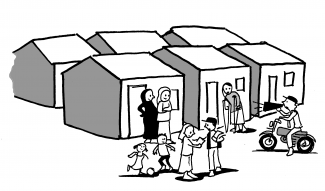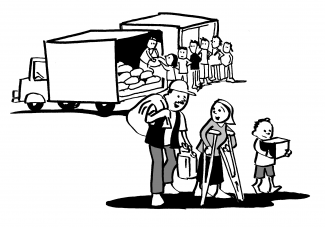Distribution

©Julie Smith
Distribution of relief items in the immediate disaster response can be inaccessible to women, men, girls and boys with disabilities due to travel distance, queues, difficult terrain and/or lack of information. Cash and/or voucher programmes are increasingly being considered as an alternative to in-kind distribution.
For inclusive distribution procedures, here comes few tips and directions:
- Invite persons with disabilities (make sure women and men are represented) when doing consultations in the planning process to design the ration cards system;
- Needs assessment has to be inclusive of women, men, girls and boys with disabilities, good data collection will ensure more inclusive and effective service provisions;
- Make available and accessible information and communication about distribution (including ration cards) by using different communication media (radio, print, pictures, etc.).
- Make sure that the distribution site is safe, accessible and reachable for everyone, including for men and women, girls and boys with disabilities, older people and women or child-headed households;
- Avoid craggy or hilly area, choose a flat site as much as possible; a uniform surface with drainage;
- Access to site should be checked: clear of rubble or other obstacles, well-signed and protected path. The ground should be flattened and compacted as much as possible;
- Put up accessible signages that indicate the location of the site;
- Plan for fast-track line for persons with disabilities and others who cannot wait for long hours in queues to make sure they receive assistance;
- Think of smaller parcel size and more regular distribution;
- Avoid prolonged waiting position for persons who have difficulties standing and moving, provide for chairs in a shadow area;
- Make sure that accessible latrines and water are available at the distribution site. The water container needs to be raised off the ground so that the tap is at a convenient height;
- Eventually, depending on the site, guiding string or rope could be made between the distribution site and the latrines to facilitate orientation for persons who are blind of with visual impairments.
- Be aware that people with mental health conditions and trauma related symptoms may find large crowds, loud noise and the distribution site distressing. Be mindful that distribution sites/occasions can also be a good time to identify people with a disabilities including those with mental health conditions.

©Julie Smith

©Julie Smith
Sources
IFRC, CBM and HI. All Under One Roof. Disability-Inclusive shelters and settlements in emergencies. IFRC. 2015.
Handicap International. Accessibility for all in emergency context. 2009